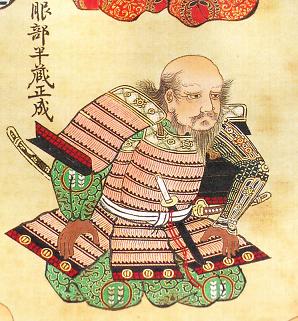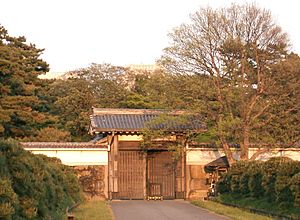Hattori Hanzō facts for kids
Quick facts for kids Hattori Hanzō |
|
|---|---|
| 服部 半蔵 | |
 |
|
| Leader of Iga Ninja | |
| In office 1557–1597 |
|
| Succeeded by | Hattori Masanari |
| Personal details | |
| Born | Hattori Masanari 服部 正成 c. 1542 Mikawa Province (now Iga-chō, Okazaki, Aichi) |
| Died | January 2, 1597 (aged 54-55) Edo, Musashi province |
| Relations | Hattori Yasunaga, 1st-Hanzō (father) Hattori Masanari, 3rd-Hanzō (son) |
| Military service | |
| Nickname(s) | "Demon Hanzō" |
| Allegiance | |
| Battles/wars | Attack on Udo Castle Siege of Kaminogō Castle Siege of Kakegawa Battle of Anegawa Battle of Mikatagahara Battle of Komaki and Nagakute Siege of Odawara |
Hattori Hanzō (服部 半蔵, c. 1542 – January 2, 1597) or Second Hanzō, nicknamed Oni no Hanzō (鬼の半蔵, Demon Hanzō), was a famous ninja of the Sengoku era, who served the Tokugawa clan as a ninja, credited with saving the life of Tokugawa Ieyasu and then helping him to become the ruler of united Japan. He is often a subject of varied portrayals in modern popular culture. Hanzō was known as an expert tactician and a master of sword fighting.
Contents
Early life
Born the son of Hattori Yasunaga (服部 保長), the First Hanzō, a minor samurai in the service of the Matsudaira (later Tokugawa) clan. His real name is Hattori Masanari (服部 正成), and he became known as the Second Hanzō. He would later earn the nickname Oni no Hanzō (鬼の半蔵, Demon Hanzō) because of the fearless tactics he displayed in his operations; this moniker also distinguished him from Watanabe Hanzo (Watanabe Moritsuna), who is nicknamed Yari no Hanzō (槍の半蔵, Spear Hanzō).
Though Hanzō was born in Mikawa Province (now Iga-chō, Okazaki, Aichi), he often returned to Iga Province, home of the Hattori family. At the age of 15, his first battle was a night time attack during the siege of Udo Castle (1557). At the time, he commanded seventy Iga ninja.
Service under Ieyasu
Hanzo had a great contribution to Tokugawa Ieyasu's rise to power, helping the future Shogun bring down the Imagawa clan. After Imagawa Ujizane had held Ieyasu's wife and son as hostages in 1561, Hanzo made a successful hostage rescue of Tokugawa's family at Kaminogo castle in 1562 and went on to lay siege to Kakegawa castle in 1569 against the Imagawa clan.
He served with distinction at the battles of Anegawa in 1570 and Mikatagahara in 1572. According to the Kansei Chōshū Shokafu, a genealogy of major samurai completed in 1812 by the Tokugawa shogunate, Hattori Hanzō rendered meritorious service during the Battle of Mikatagahara and became commander of an Iga unit consisting of one hundred fifty men. He captured a Takeda spy named Chikuan, and when Takeda's troops invaded Totomi, Hanzō counterattacked with only thirty warriors at the Tenryū River.
His most valuable contribution came in 1582 following Oda Nobunaga's death, when he led the future shōgun Tokugawa Ieyasu from the pursuit of Akechi Mitsuhide's troops to safety in Mikawa Province across Iga territory with the help of remnants of the local ji-samurai clans of the now-former Iga and Kōka confederacies. Hanzo was principal in serving as Ieyasu's guide and commanded 300 ninja guards to ensure his lord's safe passage to Mikawa.
In 1584, Hattori Hanzo continued to serve his lord at Battle of Komaki and Nagakute with 100 warriors under his command.
In 1590, Hattori Hanzo served during the Odawara campaign and was awarded 8,000 koku. By the time Ieyasu entered Kantō, he was awarded an additional 8,000 koku and had 30 yoriki and 200 public officials for his services. Ieyasu was said to have also begun to employ more Iga ninja with Hanzō as their leaders.
Historical sources say he lived the last several years of his life as a monk under the name "Sainen" and built the temple Sainenji, which was named after him and mainly built to commemorate Tokugawa Ieyasu's elder son, Tokugawa Nobuyasu.
After Nobuyasu was accused of treason and conspiracy by Oda Nobunaga and was then ordered to commit seppuku by his father, Ieyasu. Hanzo was called in to act as the official second to end Nobuyasu's suffering, but he refused to take the sword on the blood of his own lord. Ieyasu valued his loyalty after hearing of Hanzo's ordeal and said, "Even a demon can shed tears."
Death
He died at the age of 54 or 55 in 1597. There are two theories about his death. One asserts that he was assassinated by a rival Samurai, the pirate Fūma Kotarō. After Hanzo tracked him down to the Inland Sea, Kotarō lured him and his men into a small channel and used oil to set the channel on fire. The second theory is that Hanzo became a monk in Edo where he lived out the rest of his days until he died of illness.
Legacy
Hanzo's reputation as a samurai leader who commanded a 200-men strong unit of Iga warriors has grown to legendary proportions. Tales of Hattori's exploits often attributed various supernatural abilities, such as teleportation, psychokinesis, and precognition.
After his death on 4 November 1596, Hattori Hanzō was succeeded by his son, whose name was also Masanari (third Hanzō), though written with different kanji (正就 instead of 正成). He was given the title of Iwami no Kami and his Iga men would act as guards of Edo Castle, the headquarters of the government of united Japan. Hanzō is actually a name passed down through the leaders of the Hattori family meaning his father was also called Hanzō and so was his successor. Indeed, there are five people known as Hattori Hanzō throughout history.

To this day, artifacts of Hanzō's legacy remain. Tokyo Imperial Palace (formerly the shōgun's palace) still has a gate called Hanzō's Gate (Hanzōmon), and the Hanzōmon subway line which runs from Hanzōmon Station in central Tokyo to the southwestern suburbs is named after the gate, where his house was once located. The neighborhood outside Hanzō's Gate is known as Wakaba, but before 1943 was named Iga-chō ("Iga Town"). Hanzō's remains now rest in the Sainen-ji temple cemetery in Yotsuya, Tokyo. The temple also holds his favorite spear and his ceremonial battle helmet. The spear, originally 14 feet (4.3 m) long and given to him by Ieyasu, was donated to the temple by Hanzō as a votive offering, but was damaged during the bombing of Tokyo in 1945.
See also
 In Spanish: Hattori Hanzō para niños
In Spanish: Hattori Hanzō para niños
- Fūma Kotarō


